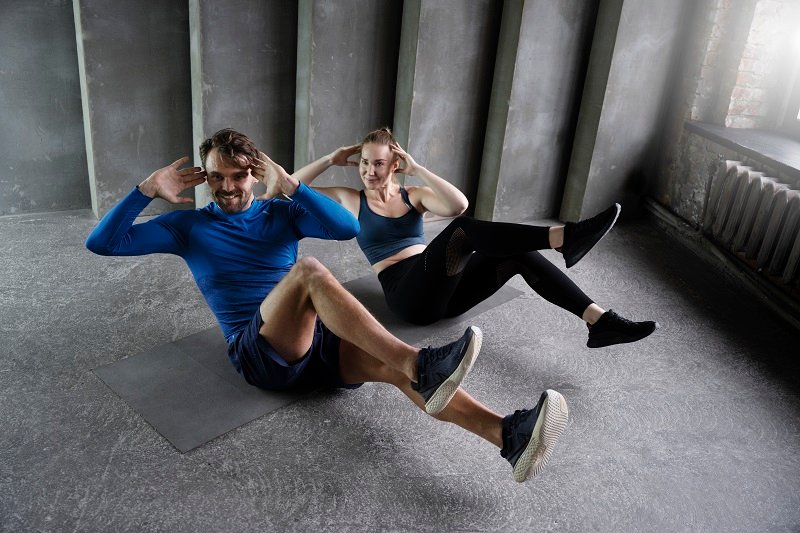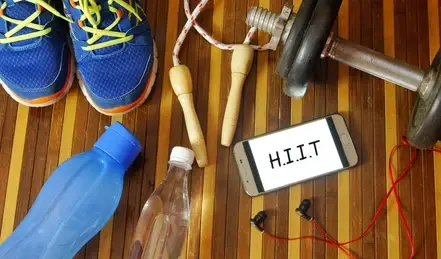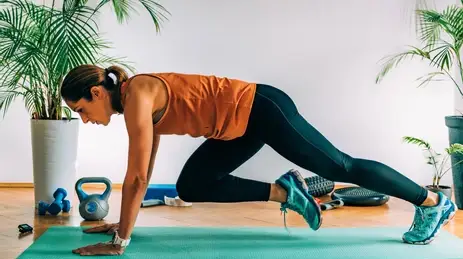What Is High-Intensity Interval Training(HIIT) & How to Do It
Published On : 6th Jan 2025

High-Intensity Interval Training, commonly known as HIIT, has taken the fitness world by storm—and for good reason. It’s an efficient, effective way to get fit, burn calories, and improve your overall health. In this blog, we’ll break down what HIIT is, how it works, and how you can start incorporating it into your fitness routine.
What Is HIIT?

HIIT is a type of workout that alternates between short bursts of intense activity and periods of rest or low-intensity exercise. These sessions are typically shorter than traditional workouts, often lasting anywhere from 15 to 30 minutes, but they pack a punch. The idea is to push your body to its maximum effort during the high-intensity intervals, followed by a recovery period to catch your breath and prepare for the next round.
Benefits of HIIT
HIIT has gained immense popularity for its ability to deliver impressive results in a short amount of time. Beyond its time efficiency, HIIT offers a range of benefits that cater to various fitness goals, making it a go-to workout for beginners and fitness enthusiasts alike.

- Time-Efficient: Perfect for busy schedules, HIIT provides maximum results in minimal time.
- Boosts Metabolism: The afterburn effect, or excess post-exercise oxygen consumption (EPOC), means your body continues burning calories even after you’ve finished.
- Improves Cardiovascular Health: Regular HIIT can enhance heart health and improve oxygen consumption.
- Burns Fat: It’s particularly effective for reducing abdominal fat and improving overall body composition.
- No Equipment Needed: Many HIIT workouts rely on bodyweight exercises, making it accessible for everyone.
How to Do HIIT
Starting with HIIT doesn’t require fancy equipment or a gym membership. Here’s how you can get started:

- Step 1: Choose Your Exercises - Select a mix of exercises that target different muscle groups. Ensure a balance of cardio, strength, and core movements to create a comprehensive workout. Examples include:
- Cardio: Exercises like jumping jacks, high knees, or sprinting to elevate your heart rate.
- Strength: Push-ups, squats, lunges, or burpees to build muscle and improve endurance.
- Core: Plank jacks, mountain climbers, or bicycle crunches to engage and strengthen your midsection.
- Step 2: Structure Your Workout - A well-structured HIIT session includes three main phases:
- Warm-Up (5 Minutes): Start with light cardio, such as jogging in place or arm circles, and dynamic stretches like leg swings to prepare your muscles and increase blood flow.
- Intervals (10-20 Minutes):
- Choose 4-6 exercises and perform each at maximum effort for 20-40 seconds.
- Follow each interval with 10-20 seconds of rest or low-intensity movement, such as walking in place.
- Complete 2-4 rounds of your selected exercises, depending on your fitness level.
- Example Intervals:
- Jumping Jacks: 30 seconds work, 15 seconds rest.
- Push-Ups: 30 seconds work, 15 seconds rest.
- Bodyweight Squats: 30 seconds work, 15 seconds rest.
- Mountain Climbers: 30 seconds work, 15 seconds rest.
Modify the timing as needed: Beginners might start with a 1:2 ratio of work to rest, such as 20 seconds of exercise followed by 40 seconds of rest.
- Cool Down (5 Minutes): Finish your session with static stretches to relax your muscles and reduce stiffness. Focus on key muscle groups like your quads, hamstrings, shoulders, and back.
Pilates is a fantastic way to strengthen your core, improve posture, and enhance overall well-being. With these simple exercises, you can create a solid foundation for your fitness journey, all from the comfort of your home. Set aside 15-20 minutes a few times a week, and you’ll start noticing the benefits in no time.
Remember to move mindfully, breathe deeply, and enjoy the process. Your core will thank you!
Sample HIIT Routine (15 Minutes)
Here’s a complete routine to get you started:

- Warm-Up (5 Minutes):
- Jog in place: 1 minute.
- Arm circles: 30 seconds forward, 30 seconds backward.
- Leg swings: 30 seconds each leg.
- Main Workout (10 Minutes):
- Jumping Jacks: 30 seconds work, 15 seconds rest.
- Push-Ups: 30 seconds work, 15 seconds rest.
- Bodyweight Squats: 30 seconds work, 15 seconds rest.
- Mountain Climbers: 30 seconds work, 15 seconds rest.
Repeat the circuit twice.
- Cool Down (5 Minutes):
- Forward fold stretch: 1 minute.
- Quad stretch: 30 seconds each leg.
- Child’s pose: 1 minute.
- Shoulder stretch: 30 seconds each arm.
- Tips for Progression:
- Increase Intensity: As you get fitter, decrease rest periods or increase work intervals.
- Add Variety: Incorporate new exercises, such as kettlebell swings or jump lunges, to keep your workouts engaging.
- Track Your Progress: Use a timer app or fitness tracker to monitor your intervals and improvements.
Tips for Success

- Start Slow: If you’re new to HIIT, begin with shorter intervals and fewer rounds, gradually increasing intensity and duration as your fitness improves.
- Focus on Form: Proper technique prevents injuries and ensures you’re targeting the right muscles.
- Listen to Your Body: Push yourself, but don’t overdo it. Rest when needed.
- Stay Consistent: Aim for 2-3 HIIT sessions per week to see results.
Is HIIT Right for You?
HIIT is versatile and can be modified to suit all fitness levels. However, it’s a demanding workout, so consult with a healthcare professional if you have any pre-existing conditions or concerns. For those who thrive on intensity and enjoy a challenge, HIIT might just become your favorite workout!

Ready to give HIIT a try? Start small, stay consistent, and watch your fitness level soar. Whether you’re a beginner or a seasoned athlete, HIIT has something to offer. Let’s get moving!






